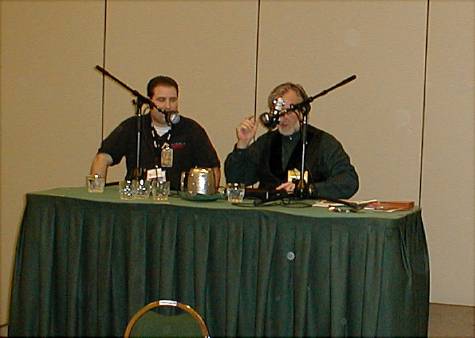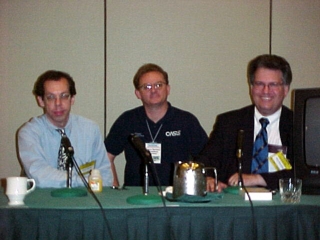






Selected Article from the
July 2001 Odyssey
Editor: Terry Hancock
More OASIS Activities at
the Agamemcon
V Convention
Steve Bartlett
Webmaster's Note: Read Part One of the AgamemCon V report in the June issue and see two galleries of photographs in the Gallery section.
Spreading the News
The local NSS chapter had other means of involving convention guests in the exploration and settlement effort besides the space and science programs, including its information booth, a web-cast featuring several of the convention guests, and a hands-on spaceship/space station craft activity.
The OASIS information booth gave space activists a one-on-one contact opportunity with hundreds of convention attendees. Our popular “Take a Piece of Mars” candy giveaway brought people to the booth, where they heard about space, received free posters, saw our simulated Mars rover in action, and had their many and varied questions answered. Booth staffers included Diane Rhodes, Tina Beychok, Karin and Craig Ward, Bob and Paula Gounley, Seth Potter, and Dr. William Ernoehazy.
 |
| Warren James interviewing Jeff Horvat for Hour 25. Photograph courtesy Steve Bartlett. |
The crew from the long-running radio show Hour 25 performed a webcast from the convention which featured a number of the space and science guests. Host Warren James interviewed Jeff Horvat, head of operations at the convention, Steve Bartlett of OASIS, Bob Gounley of JPL, and Steve Pravdo also of JPL. (The recording from the webcast can be heard by accessing the Hour 25 website: http://www.hour25online.com.)
As on previous conventions, the chapter put on its popular “How Would You Build a Spaceship/Space Station?” craft activity. Convention attendees built models of their ideas for different craft out of craft foam and other materials. Models included long-duration space probes, an advanced space station, and, to commemorate the film 2001: A Space Odyssey, various models of space ships and the ring space station from that film.
Humans in Space
In addition to the Mars and astronomy panels, guests spoke on a variety of topics relating to human activities in space, encompassing the Alpha International Space Station, Women in Space and Science, Space Medicine, the Psychology of Space Travel, conspiracy theories about faked moon landings, and long-term human exploration and settlement of the cosmos.
Norm Cook of the Boeing Company addressed living and working aboard the Alpha International Space Station. He described the facility’s design, the current arrangement of equipment on-orbit, what’s coming up in the near-term, and what the eventual configuration will be. The Station is under construction 230 miles above the Earth and has a crew of three. When construction is complete, it will house seven crew, have more experimental space than has ever been placed in orbit, and be larger than two football fields. Although Cook admitted that the design is not the best one possible, he feels that the nation and its Station partners can do a great deal of good science and learn what it takes to build other structures in space. He also cited some problems with recent decisions to scrap the crew return vehicle and the Habitation module.
Elisa Schreibman spoke on “Women in Space and Science.” The organizer of an upcoming conference on the subject in 2002, Schreibman listed numerous women in various fields relating to Space. These include: astronauts, engineers, biomedical researchers, botanists, physicists, chemists, architects, writers, computer programmers, and geologists. Her talk featured some results of mixed crews on long-duration Antarctic missions.
Dr. Ernoehazy spoke on “Space Medicine 201.” This was a follow-up to his Space Medicine 101 talk and focused on how crews aboard space stations or long-duration missions to the planets would cope with medical emergencies. He pointed out that most techniques used to treat common medical emergencies, e.g., intubations, CPR, etc., will have to undergo substantial changes to work in a zero or low gravity environment. He noted that patients would have to be restrained in different ways, intravenous fluids will have to be administered differently, and doctors will have to be anchored in different ways, among others. New tools and procedures will have to be developed to handle activities in a low gravity condition, particularly in light of the redistribution of fluids in the body at zero-G. Ernoehazy is an emergency physician in Jacksonville, Florida.
He also spoke on the psychology of space travel. Recent studies indicate that the human brain undergoes certain biochemical changes as a result of zero gravity and these have to be taken into account by crews, mission control personnel and mission planners, spacecraft designers, and others. Perceptions change, balance and coordination change, fluid balance changes, blood pressure changes, and the human response to stress changes. Part of his talk explored crew composition and selection criteria, findings on simulated Mars missions conducted in Russia, and ways of dealing with neuroses and potential psychoses on extended missions.
 |
| (l-r)Seth Potter, Steve Bartlett, and Bob Gounley for the “Conspiracy Theory: We Really DID Go to the Moon” panel. Photograph courtesy Craig Ward. |
Addressing shorter manned space missions held in the 1960’s and 70’s, members of OASIS again held our “Conspiracy Theory: We Really DID Go to the Moon” panel. The talk, a response to a recent television program on the Fox network purporting that the Apollo moon landings were faked, featured panelists: Seth Potter, Bob Gounley, and Steve Bartlett. They cited evidence of hardware being on the moon after the Apollo 11 landing, characteristics of rocket engines in a vacuum, optical effects, the political situation at the time of the Apollo landings, and numerous other areas where the television program distorted facts and ignored evidence to advance its argument.
Continuing the legacy of Apollo and beyond, Dr. Jim Busby spoke on the subject, “When Are We Going to Get Off This Rock?” Busby, from the Space Frontier Foundation, expounded on the how, when, and why humans will finally go back to the Moon, the asteroids, and on to Mars. He feels that NASA has let the American public down by “spinning around in circles” for the past twenty-eight years with the Space Shuttle instead of taking the steps necessary to explore and settle the High Frontier. Busby described the fanfare that surrounded the recent flight by space tourist Dennis Tito and how it increased public perception that the average man or woman could eventually go into space, even if the cost right now is prohibitive.
Alternative Ways to Work In Space
Performing that exploration and settlement will require alternative ways of doing things in space, including getting there and working in the harsh environment beyond Earth. Convention speakers James and Cook examined the space access arena in their talk on X-vehicles. Several programs have been started over the past few years to advance reusable launch vehicle (RLV) technology, only to be cancelled for technical, cost, or management reasons. The speakers described the numerous programs, including X-33, X-34, X-38, and others meant to push RLV technologies have been recently cancelled. Right now there is only a minimal RLV program at NASA and in the Air Force. Cook and James feel that these programs need to be more focus on the final goal of reducing space access costs, not on the “gee-whiz” technologies themselves. The speakers said that there needs to be more assessment of technical feasibility and more cost accountability for these projects to deliver the needed capabilities.
Non-governmental groups are also working on alternate ways to reach space. Steve Bartlett spoke on the work that various individuals and groups are doing in the field of amateur rocketry. From its humble beginnings, the field has expanded to the point that some amateurs have placed small payloads into near-earth space for short periods of time on suborbital flights. He talked on the types of rockets being built, the places where launches are taking place, and the organizations involved in building and flying rockets (e.g., the National Association of Rocketry, the Tripoli Rocketry Association, and the Reaction Research Society, among others).
Once in space, crews have a formidable task to assemble space stations and large interplanetary craft. The current approach that NASA employs is to train astronauts to perform this work. Several experts in the construction field have recommended using construction crews to build these structures and adopting practices similar to those used in deep diving operations. Convention speaker Duke Ogden of the Wilmington College of Oceaneering spoke on underwater construction activities, specifically welding and other operations. He gave a no-nonsense perspective on deep dive work, small, highly qualified, well-paid crews working in conditions that do not allow for mistakes. They work in everything from deep dive drilling rig platforms to repair of chemical tanks filled with hazardous materials. He suggested using deep dive crews to build space stations and orbiting spacecraft instead of “cross-trained test pilots and PhD’s.” His talk included slides from all over the world and videotape of a deep-sea oil pipeline repair effort. He stressed that teamwork was critical, particularly when working times on a section were limited to a few hours and where multiple crews had to changeover to one another.
Read Part One of the AgamemCon V report.
Copyright © 1998-2003 Organization for the Advancement of Space Industrialization and Settlement. All Rights Reserved.